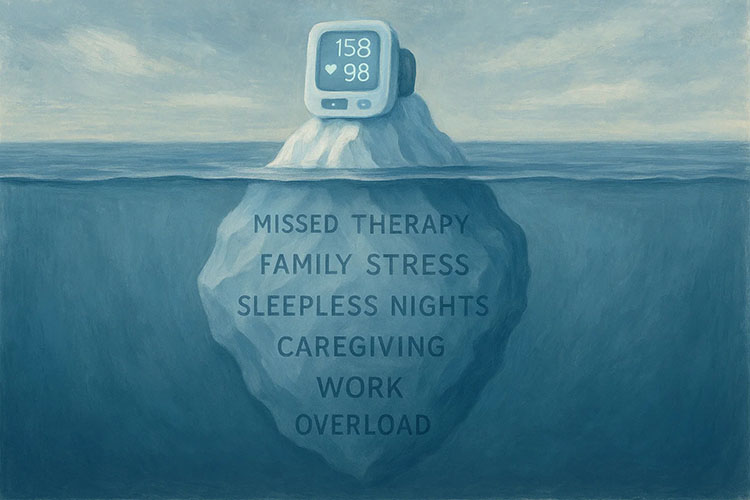
Firefighters are often thought of as bold and courageous, risking their lives for others and coming to the aid of those in need. Yet, it may be surprising to find out that, according to a Harvard study1, it isn’t fires that cause the most deaths among them; it is heart disease. The stress of their jobs, combined with lifestyle habits while at the firehouse, such as consuming quick meals crafted out of processed foods, are wreaking havoc on their health.
This revelation was brought to light when the Washington DC, area suddenly lost one of its own to a heart attack while at the scene of a fire, setting into motion a community effort to help firefighters improve their heart health.
Food On The Stove, a nonprofit started by a firefighter, began providing meals and access to healthy ingredients to the men and women at the firehouses in the Washington, DC area. The heart of the nonprofit’s approach is education, so much so that the nonprofit decided to sponsor a study to educate and motivate firefighters.
The More Foods Less Medicine Study with Remote Patient Monitoring
To add to the educational resources already out there, Food On The Stove began a new initiative. They partnered with Medek Health Systems – RPM, to conduct a four-week comprehensive study on the effect of healthy meals and education on a select group of firefighters. Participants who were identified as high-risk for heart disease volunteered to be part of the study. A lead physician conducted health evaluations and monitoring.
There were two essential components of the study.
1. Promotion of Healthy Eating Habits
Study participants actively participated by changing their eating habits for the four weeks. Three meals a day were supplied to them, and they were asked to refrain from eating sweets during this time and also to engage in some exercise.
2. Monitoring of Patient Health (with RPM and Designated Lead Physician)
Following an initial evaluation by the lead physician, each participant received a remote monitoring package provided by Medek Health, which would deliver daily glucose, blood pressure, and weight information back to the physician.
Over the course of the four weeks, each participant learned how to modify their lifestyles while the RPM tracked their progress and monitored any health status changes. Every Friday, these participants underwent individual telehealth evaluations where the physician conducted a review of RPM results and food intake.
The one exception to the planned study was if the lead physician felt the real-time data results of remote monitoring resulted in a cause for concern. If so, she would contact participants directly before that weekly telehealth appointment, showing how advantageous RPM can be for patients and attending physicians.
The Study Results: How RPM and Healthy Eating Habits Improved the Health of Firefighters
At the end of the four weeks, study participants underwent a discharge appointment, where the lead physician reviewed the lab and RPM results. With these in hand, she then made recommendations for how the firefighters could transition to maintaining healthy habits going forward.
The resulting report, More Foods Less Medicine, concluded that the participants experienced a decrease in total cholesterol and were able to lose weight, a double win for these individuals.
While providing access to healthier meals and ingredients is the outward-facing approach of the program, underneath it is the provision of education to help create a healthy mindset. In this, partnering healthy eating habits with remote patient monitoring was a win-win combination.
3 Benefits of RPM in the Study
There were many benefits of including remote patient monitoring in the study. Three, in particular, are highlighted..
1. RPM Improves Patient Education
RPM is the new way to help improve a patient’s understanding of their condition and how treatment and a change in lifestyle habits can make a difference.
For the firefighters in the study, while feeling better and being more energetic can be motivating, actually seeing how their numbers changed throughout the four weeks provided proof firsthand that changing to healthy eating habits does indeed improve their health.
With access to real-time information through a digital platform, patients can become more familiar and educated about the benefits of therapy and medication adherence, as well as how behavioral and lifestyle choices can directly affect their health.
2. RPM Identifies Adverse Events
Remote patient monitoring is a valuable way to detect adverse events and allows you to intervene quickly to prevent more harm from occurring. The lead physician in the study could reach out to participants at the first signs of an adverse event and head off any progression of a health crisis.
3. RPM Aids in Tracking Patient Progress
RPM is a powerful way to track patient progress. With it, the lead physician in the study was able to monitor changes in the patient’s health status, including any fluctuations pointing to improvements or declines. RPM also created a comprehensive view of the patient’s progress.
While this study may be considered short, just four weeks, RPM and discharge evaluations clearly show that changing to healthy eating habits can have a quick and direct effect on one’s health. The use of Medek’s health devices to track daily readings informed both the patient and the physician what effects were occurring. This helped to improve the firefighters’ health.
Ready to See How Remote Patient Monitoring Can Benefit Your Patients? Contact Medek RPM Today
To find out how remote patient monitoring can help you and your patients, contact us today.
SOURCES
1. Kales, S., Soteriades, E., Christophi, C. Christiani, D. (2007). Emergency Duties and Deaths from Heart Disease among Firefighters in the United States. The New England Journal of Medicine: NEJM, 356, 1207-1215. https://www.nejm.org/doi/full/10.1056/nejmoa060357





